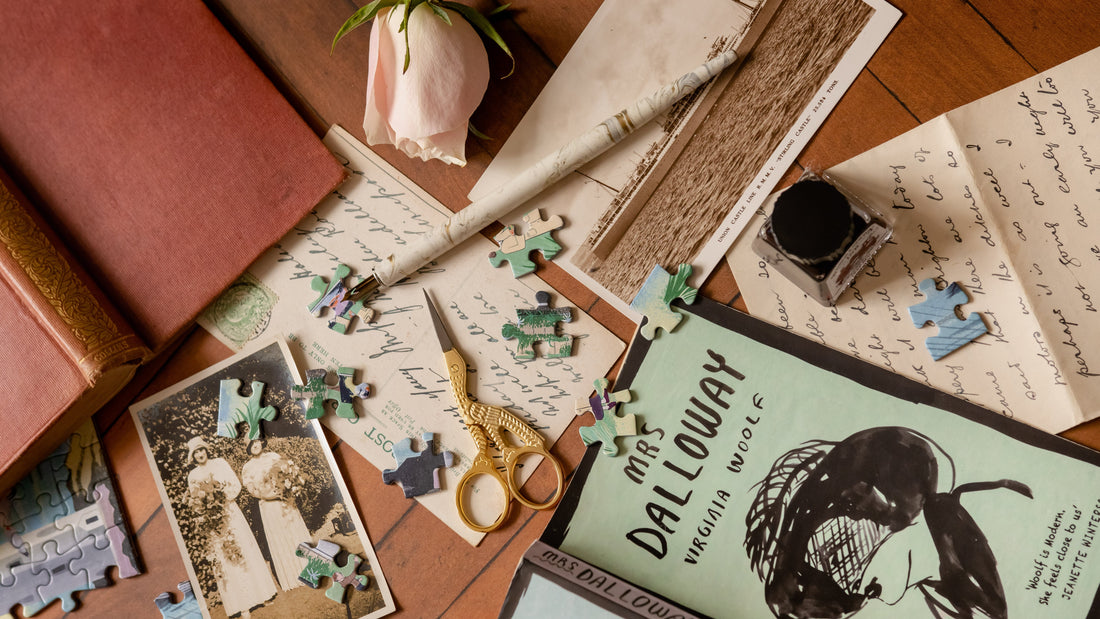In celebration of Dalloway Day, '. . . a Wednesday in mid-June . . .', and the release of The World of Virginia Woolf: a 1000-piece Jigsaw Puzzle, we asked Dr Sophie Oliver to untangle Woolf's relationship to feminism. A lecturer at the University of Liverpool who specialises in modernist writing by women, she penned the the mini essay about Virginia Woolf that accompanies the puzzle, illustrated by Eleanor Taylor.

‘Let us write that word in large black letters on a sheet of foolscap; then solemnly apply a match to the paper. Look, how it burns!’
What should we make of Virginia Woolf’s suggestion, in her 1938 essay Three Guineas, to set fire to the word feminism? It doesn’t sit comfortably with our idea of the writer who insisted, in A Room of One’s Own (1929), on women’s material liberation: that they must have £500 a year and a locked door in order to write. This inferno seems eccentric, coming from the woman who dreamt up Shakespeare’s sister, Judith, whose lack of opportunities meant she could never have achieved the genius of her brother. Surely the author of Orlando, that freewheeling novel and playful exploration of gender beyond the binary, was a feminist?
And she was. But like most things with Woolf, a modernist innovator and a deeply philosophical writer, it’s complicated. After all, feminism was an intensely debated term during Woolf’s lifetime, as it has been since. For some in the first decades of the 20th century, it meant suffrage: the fight for the vote. For others, like Woolf’s contemporaries Dora Marsden and Mary Gawthorpe, or fellow writers Rebecca West and Mina Loy, it meant something broader and more radical: a revolution in the relationship between the sexes, the liberation of all sexuality from strict moral codes, and the recasting of every individual as a free agent.
Although Woolf did have some involvement with suffrage organisations in the 1910s, her attitude towards women’s rights is more in line with that wider feminist vision of social relations reimagined. Woolf’s feminism – as it appears in her writing – is a politics of dissent. She opposes the status quo: the way that a patriarchal society supports male privilege and keeps women – keeps everyone in fact – in rigid roles. This opposition is there in her first novel, The Voyage Out (1915), which explores the evolving, faltering subjectivity and sexuality of a young woman, Rachel Vinrance, and the limits imposed on her by the pressure to marry. And Woolf’s dissidence is still there in her last book, Between the Acts, published shortly after her death in 1941: in the midst of war and its state-sanctioned violence (which Woolf also saw as patriarchal), the novel’s central character Miss La Trobe wants to unify a rural community by retelling English history through the obscure form of a theatrical pageant.
Between the Acts reminds us that Woolf’s feminism was bound up with her pacificism, but also that a writer does not only write about feminist subjects but with forms and styles that have feminist intent. Miss La Trobe’s chosen form – the pageant – challenges official ways of narrating the past. Conventional history, after all, had so often left women’s lives out of the picture. Woolf herself pioneered ways of writing that resisted the conventions of literary history. Mrs Dalloway (1925) gives us the interior thoughts of its characters, particularly the reflections, memories, anxieties and desires of Clarissa Dalloway as she goes about her day in London. It is with this access to her inner life that we can see Clarissa chafing against the exterior things that limit her: the British ruling class dominated by men and masculine values, the medical establishment, her marriage and heterosexuality. To the Lighthouse (1927) uses a similar ‘stream of consciousness’ to show that the thoughts of Mrs Ramsay, a mother, are worth our attention, that Mr Ramsay – the novel’s patriarch – is privately obsessed with his status and reputation, and that the unmarried artist Lily Briscoe is haunted by a misogynistic comment: ‘women can’t paint, women can’t write’.
In A Room of One’s Own, Woolf maintains that restrictions on women’s creativity are social, not innate: women have been expected to raise children and keep homes, they have not been allowed a wide education, or to control their own money, so when and how could they have painted or written? Still, later writers have questioned how inclusive this account was. Audre Lorde, for example, reasoned that ‘A room of one's own may be a necessity for writing prose, but so are reams of paper, a typewriter, and plenty of time.’ In other words: some women – women who must support themselves and their families (Lorde was thinking specifically about poor and working-class women, and women of colour) – often can’t afford the materials or extended periods of time needed to write.
Despite Woolf’s blind spots, she shared with Lorde an opposition to the unequal structures maintained in a patriarchal society. But she also tried to see beyond sexual difference, a vision that Lorde, who always insisted on the recognition of difference, would surely have rejected. It is surely Woolf’s relative freedom, fortified by her £500 a year, which permits her to imagine, in A Room, a world after gender, a kind of androgynous mindset in which women will be able to write without thinking about their sex.
And perhaps this, then, is what Woolf meant when she threw feminism on the bonfire. If your feminism is a tool for changing how society is organised, you might hope – if you are materially comfortable enough to dream in this way – that eventually it won’t be necessary: that all ways of thinking and being based on a hierarchy between genders, including feminism itself, will go up in a blaze.
Read more of Dr Sophie Oliver's thoughts on Virginia Woolf, and immerse yourself in Woolf's universe through our latest jigsaw puzzle: The World of Virginia Woolf, available now.


